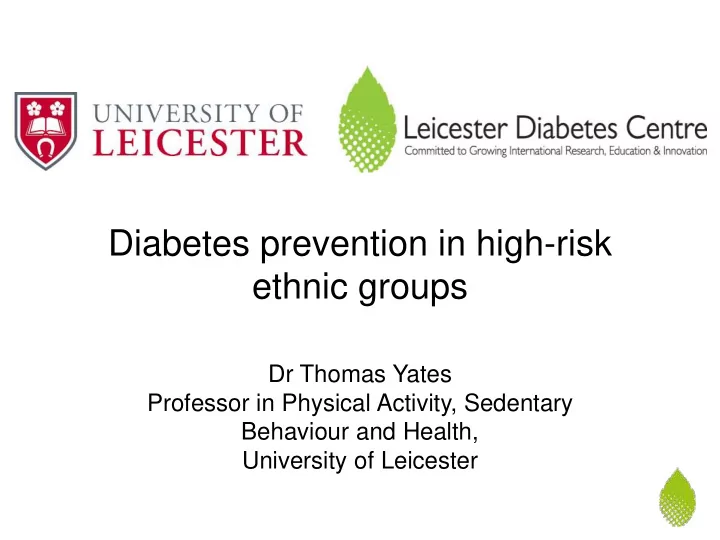

Diabetes prevention in high-risk ethnic groups Dr Thomas Yates Professor in Physical Activity, Sedentary Behaviour and Health, University of Leicester
Aims • Ethnic disparities in diabetes risk • Importance of lifestyle to ethnic health • Prevention programmes for ethnic minorities
Diabetes since 1980 NCD Risk Factor Collaboration Lancet 2016 Commentary Yates & Khunti Nature Rev Endocrinol 2016 Per 100 Million 5 422 million = 1 in 11 4 Not explained by population growth 3 2 Explained by population 108 million = 1 in 25 growth 1 1980 level 0 1980 2014
Diabetes prevalence and incidence in the UK % 9 8 7 6 5 4 3 2 1 0 Diabetes Audit diabetes prevalence RCGP diabetes prevalence RCGP diabetes incidence per year White European African-Caribbean Asian English S, et al (2016) Diabetes & Primary Care 18: 28 – 32
Consistent with other countries Agyemang, et al. Epidemiology2011;22(4):563-567
Glucose response to mixed meals Meal Data taken from Yates et al. The journals of gerontology. Series A 2018 doi: 10.1093/gerona/gly252
Insulin response to mixed meals Data taken from Yates et al. The journals of gerontology. Series A 2018 doi: 10.1093/gerona/gly252
UK Biobank data HbA1c Triglycerides 42 2.5 41 2 Triglycerides (mmol/L) 40 HbA1c (mmol/mol) 39 1.5 38 37 1 36 35 0.5 34 33 0 Unadjusted model Fully adjusted model Unadjusted model Fully adjusted model WE SA BAC WE SA BAC Cholesterol-HDL ratio C-reative protein 4.6 3.5 Cholesterol-HDL ratio C-reative protein (mg/L) 3 4.4 2.5 4.2 2 4 1.5 3.8 1 3.6 0.5 3.4 0 3.2 Unadjusted model Fully adjusted model Unadjusted model Fully adjusted model WE SA BAC WE SA BAC
Conclusions Part 1 • South Asian phenotype at particularly high risk of insulin resistance and type 2 diabetes • Risk greater than White European and other ethnic groups
Part 2 Importance of body weight and lifestyle factors
BMI and diabetes prevalence Ntuk et al. Diabetes care. 2014 Sep 1;37(9):2500-7.
Fat overspill From www.myhealthywaist.org
Associations between physical activity and health Celis-Morales et al. PloS one. 2013 Dec 11;8(12):e82568.
Odds of impaired glucose regulation by ethnicity and activity (Yates et al. 2012) OR 4 3.1 P = 0.013 for interaction 3 1.51 2 1.18 1 1 0.61 0.71 0.69 0.61 South Asian 0 White European Quartile 1 Quartile 2 Quartile 3 Quartile 4 Data taken from Yates T et al. International journal of epidemiology. 2013 18;42(2):533-40.
Impact of exercise on lipids Arjunan et al MSSE 2013;45(7):1261-8.
Exercise and insulin resistence Insulin (mU · L -1 ) Chart Title 180 160 140 120 100 80 60 40 20 0 Control Continious exercise HIIT White European South Asian Data from the Leicester Go for IT trial
Importance of sedentary behaviour and light-intensity physical activity Ekelund et al. bmj. 2019;366:l4570.
Leicester acute sedentary trials (n = 129)
Insulin response to breaking sitting
Difference in physical activity levels (Yates et al. 2010, Prev Med) MET.hr/week MET.hr/week 50 50 45 45 40 40 35 35 30 30 South Asian 25 25 White 20 20 European 15 15 10 10 5 5 0 0 Women Men
Objectively assessed physical activity Biddle et al. BMC public health. 2019 Dec;19(1):95.
Walking pace and life expectancy Proportion reporting habitual brisk walking South Asian = 19% White European = 40% Zaccardi et al. Mayo Clinic Proceedings 2019; 94: 985-994
South Asian Risk (Ghouri et al Diabetologia 2013) HOMA-IR Fitness (ml/kg.min) 83% of ethnic 3.5 45 difference explained 40 by fitness and 3 physical activity 35 2.5 30 2 25 20 1.5 15 1 10 0.5 5 0 0 Europeans South Asians Europeans South Asians
Over 20% of difference explained by lower levels of physical activity in South Asian groups Williams et al. Heart. 2011;97(8):655-9.
Differences in diet Some evidence that south Asians consume a less healthy diet, including • Less fruit, vegetables and fibre • More processed grains (e.g. white rice) • Higher ratio of ω -6 to ω -3 Data less consistent or clear than for physical activity Misra et al. International journal of obesity. 2011;35(2):167
Conclusions Part 2 • South Asian get a greater health benefit for a given improvement in body weight, physical activity or diet • However, substantial behaviour change is needed to normalise risk • Low fitness and physical activity explain much of the disease burden in South Asian communities
Can diabetes be prevented in South Asians Modesti et al. Internal and emergency medicine. 2016 Apr 1;11(3):375-84.
Cultural barriers: Fatalism (Lawton et al. 2006 Health Education Research) “God has given me this disease of sugar. Whatever happens, it happens because God wants it to happen” “With age, as you know, you become weaker, and there is not much you can do about it”
Other barriers (Horne & Tierney 2012 Preventive Medicine ) • Physical activity seen as exacerbating ill health • Importance of food with social occasions • Cultural norms pertaining to gender roles • Unfamiliar with local geography and lack of culturally sensitive facilities
Enablers (Horne & Tierney 2012 Preventive Medicine ) • Support from family • Peer-support
Family based prevention programme
NIHR CLAHRC East Midlands NIHR Programme Grant RP-PG-0606-1272
Translating prevention into routine care 1688 individuals and 54 GP practices recruited Followed up for 3 years Average increase of 400 steps/day
Impact of depression on behaviour change Yates et al. Diabetes care. 2019 Oct 1;42(10):1847-53.
Depression and South Asians Razieh et al. Diabetic Medicine. 2019 https://doi.org/10.1111/dme.13986
Conclusion Part 3 • Diabetes can be prevented in Black and minority ethnic communities, but has to be tailored to cultural norms and perceptions • Impact of depression is likely to be a key factor of importance
Thank you www.leicesterdiabetescentre.org.uk www.facebook.com/LeicesterDiabetesCentre @LDC_Tweets
Recommend
More recommend